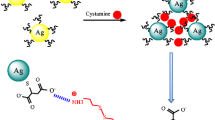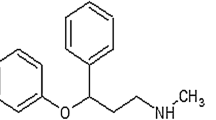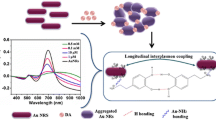Abstract
A novel method towards spectrophotometric determination of catecholamines and their metabolites differing in their functional groups has been developed. This method is based on a change in morphology of silver triangular nanoplates upon the action of cateсholamines and their metabolites, which is manifested by the decrease of the nanoparticle local surface plasmon resonance (LSPR) band intensity or its shift to the short-wavelength region of the spectrum. The shift value of the LSPR band or the change of its intensity increases with increasing concentration of catecholamines or their metabolites, which is proposed for their spectrophotometric determination. The limits of detection of catecholamines and their metabolites under selected conditions increase in the series homovanillic acid < vanillylmandelic acid < L-epinephrine < L-norepinephrine < dopamine and are 0.25, 1.2, 3.0, 64, and 130 μmol L−1, respectively. The selectivity of the proposed method was assessed using vanillylmandelic acid as example. It was found that the determination of vanillylmandelic acid does is not interfered in the presence of 4000-fold excess of Na+, K+, CH3COO−, and 1000-fold excess of Mg2+, Ca2+, Al3+, NO3−. The method also allows for the selective determination of vanillylmandelic acid in the presence of a 1000-fold excess of structurally related substances that do not contain either a catechol fragment or an electron donor substituent. The proposed approach was successfully applied to the determination of catecholamines in pharmaceuticals and artificial urine.

Graphical abstract




Similar content being viewed by others
References
Tsogas GZ, Kappi FA, Vlessidis AG, Giokas DL (2018) Recent advances in nanomaterial probes for optical biothiol sensing: a review. Anal Lett 51:443–468
Apyari VV, Dmitrienko SG, Gorbunova MV, Furletov AA, Zolotov Yu A (2019) Gold and silver nanoparticles in optical molecular absorption spectroscopy. J Anal Chem 74:21–32
Apyari VV, Terenteva EA, Kolomnikova AR, Garshev AV, Dmitrienko SG, Zolotov Yu A (2019) Potentialities of differently-stabilized silver nanoparticles for spectrophotometric determination of peroxides. Talanta 202:51–58
Kappi FA, Tsogas GZ, Giokas DL, Christodouleas DC, Vlessidis AG (2014) Colorimetric and visual read-out determination of cyanuric acid exploiting the interaction between melamine and silver nanoparticles. Microchim Acta 181:623–629
Wang C, Bi X, Wang M, Zhao X, Lin Y (2019) Dual-channel online optical detection platform integrated with a visible light absorption approach for continuous and simultaneous in vivo monitoring of ascorbic acid and copper(II) ions in a living rat brain. Anal Chem 91:16010–16016
Yan P, Ding Z, Li X, Dong Y, Fu T, Wu Y (2019) Colorimetric sensor array based on Wulff-type boronate functionalized AgNPs at various pH for bacteria identification. Anal Chem 91:12134–12137
Tippayawat P, Phromviyo N, Boueroy P, Chompoosor A (2016) Green synthesis of silver nanoparticles in aloe vera plant extract prepared by a hydrothermal method and their synergistic antibacterial activity. PeerJ 4. https://doi.org/10.7717/peerj2589
Khodashenas B, Ghorbani HR (2019) Synthesis of silver nanoparticles with different shapes. Arab J Chem 12:1823–1838
Haifa SA-G, Waleed EM (2013) One pot synthesis of multi-plasmonic shapes of silver nanoparticles. Mater Lett 105:62–64
Kim B-H, Lee J-S (2015) One-pot photochemical synthesis of silver nanodisks using a conventional metal-halide lamp. Mater Chem Phys 149–150:678–685
Sharma D, Rakshana DA, Balakrishnan RM, JagadeeshBabu PE (2019) One step synthesis of silver nanowires using fructose as a reducing agent and its antibacterial and antioxidant analysis. Mater Res Express 6. https://doi.org/10.1088/2053-1591/ab170a
Pourjavadi A, Soleyman R (2011) Novel silver nano-wedges for killing microorganisms. Mater Res Bull 46:1860–1865
Shaheen T, Fouda A (2018) Green approach for one–pot synthesis of silver nanorod using cellulose nanocrystal and their cytotoxicity and antibacterail assessment. Int J Biol Macromol 106:784–792
Haber J, Sokolov K (2017) Synthesis of stable citrate-capped silver nanoprisms. Langmuir 33:10525–10530
Marta B, Jakab E, Potara M, Simon T, Imre-Lucaci F, Barbu-Tudoran L, Popescu O, Astilean S (2014) Pluronic-coated silver nanoprisms: synthesis, characterization and their antibacterial activity. Colloids Surf A Physicochem Eng Asp 441:77–83
Furletov AA, Apyari VV, Garshev AV, Volkov PA, Dmitrienko SG (2019) Silver triangular nanoplates as a colorimetric probe for sensing thiols: characterization in the interaction with structurally related thiols of different functionality. Microchem J 147:979–984
Wang Y, Yang Y, Liu W, Ding F, Zhao Q, Zou P, Wang X, Rao H (2018) Colorimetric and fluorometric determination of uric acid based on the use of nitrogen-doped carbon quantum dots and silver triangular nanoprisms. Microchim Acta 185. https://doi.org/10.1007/s00604-018-2814-6
Shen J, Sun C, Wu X (2017) Silver nanoprisms-based Tb(III) fluorescence sensor for highly selective detection of dopamine. Talanta 165:369–376
Zhang P, Wang L, Zeng J, Tan J, Long Y, Wang Y (2020) Colorimetric captopril assay based on oxidative etching-directed morphology control of silver nanoprisms. Microchim Acta 187. https://doi.org/10.1007/s00604-019-4071-8
Fang X, Ren H, Zhao H, Li Z (2017) Ultrasensitive visual and colorimetric determination of dopamine based on the prevention of etching of silver nanoprisms by chloride. Microchim Acta 184:415–421
Djelić N, Radaković M, Borozan S, Dimirijević-Srećković V, Pajović N, Vejnović B, Borozan N, Bankoglu E, Stopper H, Stanimirović Z (2019) Oxidative stress and DNA damage in peripheral blood mononuclear cells from normal, obese, prediabetic and diabetic persons exposed to adrenaline in vitro. Mutat Res Genet Toxicol Environ Mutagen 843:81–89
Whiting M, Doogue M (2009) Advances in biochemical screening for pheochromocytoma using biogenic amines. Clin Biochem Rev 30:3–17
Y-Hassan S (2019) Plasma epinephrine level and its causal link to Takotsubo syndrome revisited: critical review with a diverse conclusion. Cardiovasc Revasc Med 20:907–914
Shaikshavali P, Madhusudana Reddy T, Ven Gopal T, Venkataprasad G, Kotakadi V S, Palakollu V N, Karpoormath R (2020) A simple sonochemical assisted synthesis of nanocomposite (ZnO/MWCNTs) for electrochemical sensing of epinephrine in human serum and pharmaceutical formulation. Colloids Surf A 584. https://doi.org/10.1016/jcolsurfa2019124038
Beitollahi H, Dourandish Z, Tajik S, Ganjali MR, Norouzi P, Faridbod F (2018) Application of graphite screen printed electrode modified with dysprosium tungstate nanoparticles in voltammetric determination of epinephrine in the presence of acetylcholine. J Rare Earth 36:750–757
Sun Y, Wang S, Zhang X, Huang Y (2006) Simultaneous determination of epinephrine and ascorbic acid at the electrochemical sensor of triazole SAM modified gold electrode. Sensors Actuators B 113:156–161
Anithaa AC, Lavanya N, Asokan K, Sekar C (2015) WO3 nanoparticles based direct electrochemical dopamine sensor in the presence of ascorbic acid. Electrochim Acta 167:294–302
Amjadi M, Hallaj T, Manzoori JL, Shahbazsaghir T (2018) An amplified chemiluminescence system based on Si-doped carbon dots for detection of catecholamines. Spectrochim Acta A 201:223–228
Zhu L, Xu G, Song Q, Tang T, Wang X, Wei F, Hu Q (2016) Highly sensitive determination of dopamine by a turn-on fluorescent biosensor based on aptamer labeled carbon dots and nano-graphite. Sensors Actuators B 231:506–512
Gorbunova M, Gutorova S, Berseneva D, Apyari V, Zaitsev V, Dmitrienko S, Zolotov Y (2019) Spectroscopic methods for determination of catecholamines: a mini-review. Appl Spectrosc Rev 54:631–652
Godoy-Reyes TM, Costero AM, Gaviña P, Martínez-Máñez R, Sancenón F (2019) Colorimetric detection of normetanephrine, a pheochromocytoma biomarker, using bifunctionalised gold nanoparticles. Anal Chim Acta 1056:146–152
Gorbunova MV, Apyari VV, Zolotov II, Dmitrienko SG, Garshev AV, Volkov PA, Bochenkov VE (2019) A new nanocomposite optical sensor based on polyurethane foam and gold nanorods for solid-phase spectroscopic determination of catecholamines. Gold Bull 52:115–124
Dunand M, Gubian D, Stauffer M, Abid K, Grouzmann E (2013) High–throughput and sensitive quantitation of plasma catecholamines by ultraperformance liquid chromatography–tandem mass spectrometry using a solid phase microwell extraction. Anal Chem 85:3539–3544
Ma J-B, Qiu H-W, Rui Q-H, Liao Y-F, Chen Y-M, Xu J, Zhan P-P, Zhao Y-G (2016) Fast determination of catecholamines in human plasma using carboxyl-functionalized magnetic-carbon nanotube molecularly imprinted polymer followed by liquid chromatography-tandem quadrupole mass spectrometry. J Chromatogr A 1429:86–96
Clark ZD, Cutler JM, Pavlov IY, Strathmann FG, Frank EL (2017) Simple dilute-and-shoot method for urinary vanillylmandelic acid and homovanillic acid by liquid chromatography tandem mass spectrometry. Clin Chim Acta 468:201–208
Zhang G, Zhang Y, Ji C, McDonald T, Walton J, Groeber E, Steenwyk R, Lin Z (2012) Ultra sensitive measurement of endogenous epinephrine and norepinephrine in human plasma by semi-automated SPE-LC-MS/MS. J Chromatogr B 895:186–190
Abkhalimov EV, Timofeev AA, Ershov BG (2018) Electrochemical mechanism of silver nanoprisms transformation in aqueous solutions containing the halide ions. J Nanopart Res 20:26. https://doi.org/10.1007/s11051-018-4133-6
Němečková-Makrlíková A, Navrátil T, Barek J, Štenclová P, Kromka A, Vyskočil V (2019) Determination of tumour biomarkers homovanillic and vanillylmandelic acid using flow injection analysis with amperometric detection at a boron doped diamond electrode. Anal Chim Acta 1087:44–50
Baluchová S, Barek J, Tomé LIN, Brett CMA, Schwarzová-Pecková K (2018) Vanillylmandelic and homovanillic acid: electroanalysis at non-modified and polymer-modified carbon-based electrodes. J Electroanal Chem 821:22–32
Li X, Jin W, Weng Q (2002) Separation and determination of homovanillic acid and vanillylmandelic acid by capillary electrophoresis with electrochemical detection. Anal Chim Acta 461:123–130
Funding
This study was financially supported by the Russian Science Foundation (grant no. 18-73-10001). Some studies were performed using instrumentation provided according to the M.V. Lomonosov Moscow State University Program of Development.
Author information
Authors and Affiliations
Corresponding author
Ethics declarations
Conflict of interest
The authors declare that they have no conflict of interest.
Additional information
Publisher’s note
Springer Nature remains neutral with regard to jurisdictional claims in published maps and institutional affiliations.
Electronic supplementary material
ESM 1
(PDF 694 kb)
Rights and permissions
About this article
Cite this article
Zaytsev, V.D., Furletov, A.A., Apyari, V.V. et al. Label-free silver triangular nanoplates for spectrophotometric determination of catecholamines and their metabolites. Microchim Acta 187, 610 (2020). https://doi.org/10.1007/s00604-020-04576-1
Received:
Accepted:
Published:
DOI: https://doi.org/10.1007/s00604-020-04576-1




